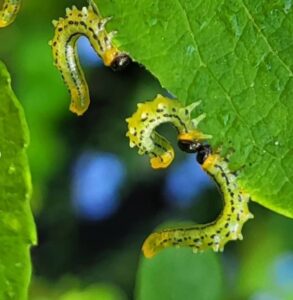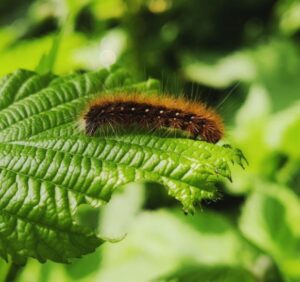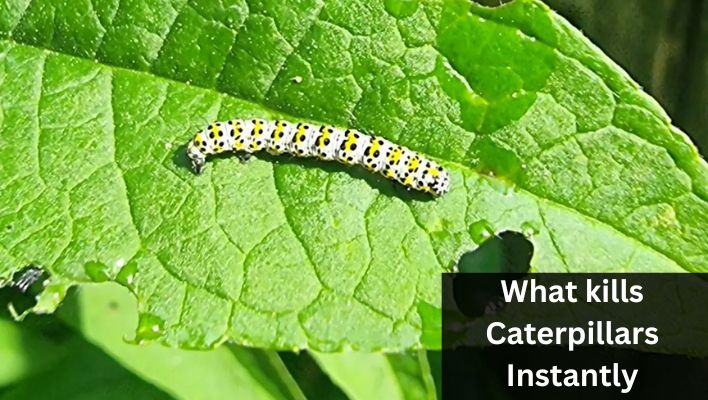Have you ever walked into your garden, only to find your beautiful plants under attack by voracious caterpillars? It’s a frustrating sight for any gardener or farmer who has put time and effort into nurturing their green space. we will delve into the intriguing world of caterpillar control, exploring the question on every gardener and farmer’s mind: What kills caterpillars instantly?
Caterpillars, the larval stage of butterflies and moths, can wreak havoc on your plants, causing defoliation and stunted growth. But fear not! In this comprehensive guide, we will delve into the world of caterpillar control and explore various methods to eliminate these pests instantly.
Caterpillar control is of utmost importance in gardening and farming. These seemingly harmless creatures possess a remarkable ability to devour leaves, flowers, and fruits, jeopardizing the health and productivity of your beloved plants.
Not only can caterpillars cause aesthetic damage, but they can also weaken plants, making them more susceptible to diseases and other pest attacks. Now, let’s turn our attention to the pressing question: what kills caterpillars instantly?
We understand the urgency of the situation and the need for effective solutions. Below we will explore a range of methods that can swiftly eliminate caterpillar populations, giving you the power to protect your plants and restore balance to your garden. Whether you prefer natural approaches, organic solutions, or chemical interventions, we have you covered.
Understanding Caterpillars
Caterpillars, the larval stage of butterflies and moths, are fascinating creatures that play an important role in our ecosystems.
They come in various sizes, colors, and patterns, captivating our attention as they move and feed on plants.
However, despite their charm, caterpillars can pose significant challenges in gardening and farming, making it necessary to control their populations. Here’s why:
Feeding Habits:
Caterpillars are voracious eaters, with insatiable appetites for plant leaves, stems, and fruits. They can quickly defoliate and damage plants, leading to stunted growth, reduced yield, and even plant death.
In agriculture, caterpillar infestations can result in substantial economic losses and jeopardize food production.

Crop Damage:
Caterpillars can target a wide range of crops, including vegetables, fruits, and ornamental plants. They feed on plant tissues, leaving behind chewed leaves and unsightly damage.
Additionally, some caterpillar species, like the corn earworm or tomato hornworm, target specific crops, causing severe crop losses if left unchecked.
Plant Health:
Beyond the immediate damage caused by feeding, caterpillars can weaken plants and make them more susceptible to other pests and diseases.
Open wounds and chewed leaves provide entry points for pathogens and can compromise the overall health of plants. Controlling caterpillar populations helps maintain the vitality and productivity of plants.
Ecological Balance:
While caterpillars play a vital role in the natural food chain, an imbalance in their populations can disrupt ecosystems. Excessive caterpillar feeding can lead to the decline of plant species, affecting the availability of food and habitat for other organisms. By managing caterpillar populations, we can help maintain a healthy ecological balance.
To protect your plants and ensure their optimal growth, it becomes necessary to control caterpillar infestations.
By employing appropriate methods, such as natural predators, organic solutions, or targeted insecticides, you can effectively manage caterpillars while minimizing harm to beneficial insects and the environment.
Striking a balance between the presence and control of caterpillars allows us to coexist with these intriguing creatures while safeguarding our plants and agricultural endeavors.
What kills caterpillars instantly?
Organic pest control methods are a popular choice for those seeking environmentally friendly and safe options to kill caterpillars instantly.
One go-to organic solution that has proven effective is Bacillus thuringiensis (Bt). Bt is a naturally occurring bacterium that specifically targets and kills caterpillars while sparing beneficial insects, birds, and mammals.

Bt works by producing proteins that are toxic to caterpillars when ingested. Once a caterpillar consumes Bt-treated foliage, these proteins attack the caterpillar’s digestive system, leading to paralysis and ultimately death. The best part is that Bt is harmless to humans, pets, and beneficial insects like bees and ladybugs.
To use Bt effectively, you can find it in liquid or powder form. Dilute the concentrate according to the manufacturer’s instructions and apply it directly to the affected plants, ensuring thorough coverage of leaves and stems. Bt is most effective when caterpillars are in their early stages, so it’s crucial to monitor your plants closely for any signs of infestation.
Remember, organic solutions like Bt may take a little longer to show results compared to chemical insecticides, but they offer a sustainable and non-toxic alternative. By choosing organic options, you can maintain a healthy balance in your garden or farm while effectively eliminating caterpillars instantly.
Other Insecticides to Kill Caterpillars
When it comes to chemical solutions for immediate caterpillar elimination, there are several brands that offer effective results. Here are three brands of chemical insecticides along with their active ingredients, targeted caterpillar species, and necessary precautions:
Sevin Insect Killer:


Active Ingredient: Carbaryl Targeted Caterpillar
Species: Tomato Hornworms, Cabbage Loopers, Gypsy Moth Larvae, and various other caterpillars Precautions and Safety Measures:
- Carefully read and adhere to the instructions provided by the manufacturer.
- Apply the product during calm weather conditions to minimize drift and ensure proper coverage.
- Wear protective clothing, including long sleeves, long pants, gloves, and goggles, during application.
- Keep children and pets away from treated areas until the product has dried.
- Avoid using near water sources or edible crops, unless explicitly mentioned as safe on the product label.
- Store the insecticide in a cool, dry place, away from direct sunlight and heat.
Monterey Garden Insect Spray

Active Ingredient: Spinosad Targeted Caterpillar Species: Tomato Hornworms, Armyworms, Cutworms, and various caterpillar species Precautions and Safety Measures:
- Read and follow the instructions provided by the manufacturer.
- Wear protective clothing, including gloves and goggles, when applying the product.
- Avoid spraying during windy conditions to minimize drift.
- Keep children and pets away from treated areas until the spray has dried.
- Store the product in a secure area, out of reach of children and animals.
- Follow any additional precautions and safety measures mentioned on the product label.
It’s essential to remember that while chemical insecticides can provide instant results, they should be used judiciously and as a last resort due to potential harm to beneficial insects and the environment. Always prioritize the safety precautions outlined by the manufacturer and consider alternative, less-toxic methods of caterpillar control whenever possible.
Ortho Insect Killer:
Active Ingredients: Bifenthrin, Zeta-Cypermethrin, and Tau-Fluvalinate Targeted Caterpillar
Species: Armyworms, Cutworms, Tent Caterpillars, and other common garden caterpillars Precautions and Safety Measures:

- Read and follow the instructions and warnings provided on the product label.
- Wear protective clothing, such as gloves and goggles, during application.
- Keep children and pets away from treated areas until the product has dried.
- Avoid spraying near water sources or edible plants, unless specifically mentioned as safe on the product label.
- Store the product in a cool, dry place, away from food and out of reach of children.
Other Methods to kill caterpillars instantly
In addition to the organic option of Bacillus thuringiensis (Bt), there are several other effective methods to kill caterpillars instantly. Let’s explore some of these options:
Natural Predators:
Encouraging natural predators in your garden or farm is an effective way to control caterpillar populations. Birds, such as robins, sparrows, and chickadees, feed on caterpillars and can help keep their numbers in check.
You can attract birds by providing birdhouses, bird baths, and bird feeders. Additionally, certain wasp species and beneficial insects like ladybugs and lacewings prey on caterpillars, making them valuable allies in natural pest control.
Handpicking:
While it may be time-consuming, manually removing caterpillars from plants is a simple and immediate solution.
Inspect your plants regularly and carefully pick off any visible caterpillars, dropping them into a bucket of Vinegar with water to ensure they don’t return.
This method works best for smaller infestations or when dealing with larger caterpillars that are easy to spot.
Homemade Remedies:
Several homemade remedies can be effective in killing caterpillars instantly. Garlic spray, made by blending garlic cloves with water, acts as a natural repellent and disrupts caterpillar feeding.
Another option is a chili pepper spray, created by combining chopped chili peppers with water. The spicy nature of the spray deters caterpillars from feeding on plants.
Neem Oil:
Neem oil, derived from the neem tree, is a versatile and natural insecticide that can help control caterpillar infestations. It disrupts the caterpillar’s hormonal system, inhibiting their feeding and growth.
Dilute neem oil according to the manufacturer’s instructions and spray it on affected plants, targeting both the upper and lower leaf surfaces.

Diatomaceous Earth:
Diatomaceous earth is a natural powder made from fossilized remains of tiny aquatic organisms. It works by dehydrating and damaging the exoskeleton of caterpillars, causing their demise.
Sprinkle a thin layer of diatomaceous earth around the base of plants or directly on the affected foliage. Reapply after rain or watering.
Companion Planting:
Certain plants emit natural compounds that repel caterpillars. Incorporating these companion plants into your garden can help deter caterpillar infestations.
For example, planting herbs like mint, rosemary, or basil alongside your susceptible plants can act as a natural repellent.
Cultural Practices:
Implementing cultural practices in your gardening routine can contribute to reducing caterpillar populations. Regularly remove and destroy any fallen leaves or plant debris where caterpillars might hide. Additionally, rotating your crops each season helps disrupt the life cycle of caterpillars and reduces the risk of recurring infestations.
Remember, before choosing a method, consider the scale of the infestation, the type of plants you have, and your desired level of environmental impact.
Combining different methods and regularly monitoring your plants for signs of caterpillar activity will help ensure effective control.
Each method has its advantages and limitations, so it’s essential to choose the most suitable options based on your specific situation and preferences.
What Kills Caterpillars Instantly FAQs
What are the signs of a caterpillar infestation?
Several signs indicate a caterpillar infestation:
- Chewed or skeletonized leaves: Caterpillars feed voraciously, often leaving behind distinct feeding patterns on leaves, including irregular holes or complete defoliation.
- Presence of droppings: Caterpillar droppings, also known as frass, can accumulate on leaves or the ground beneath affected plants.
- Silk or webbing: Some caterpillars, like tent caterpillars or webworms, create silk webs or nests as they feed and move within plants.
- Caterpillar sightings: Spotting caterpillars themselves crawling on plants or hiding in foliage is a clear indication of an infestation.
How can I identify caterpillars that are harmful to my plants?
Identifying harmful caterpillars involves careful observation. Look for the following characteristics:
- Feeding behavior: Caterpillars that aggressively consume plant foliage and cause visible damage are likely harmful.
- Appearance: Note the caterpillar’s color, size, and markings. Some harmful caterpillars have distinctive features like spines, horns, or patterns that help with identification.
- Host plant preference: Certain caterpillar species specialize in specific host plants. Research common pests affecting your plant species to narrow down the possibilities.
- Research or expert guidance: Consult local agricultural extension services, online resources, or gardening communities for assistance in identifying harmful caterpillars common to your region.
Can caterpillars kill mature plants?
While caterpillars can cause significant damage to plants, it is rare for them to kill mature and healthy plants on their own.
However, severe infestations, especially when combined with other stresses like drought or disease, can weaken plants to the point where they may succumb or experience long-term damage.
Early detection and effective control measures are essential to prevent severe damage and potential plant loss.

Are all caterpillars harmful, or are there beneficial ones?
Not all caterpillars are harmful. Some caterpillars play beneficial roles in ecosystems. Many caterpillars eventually transform into butterflies or moths that contribute to pollination and serve as a food source for other organisms.
Additionally, some caterpillars feed on pests, helping to naturally control populations of harmful insects. It’s important to identify the specific caterpillar species to determine if it is harmful or beneficial to your plants.
Is it safe to use chemical insecticides in my garden?
The safety of chemical insecticides depends on several factors:
- Follow instructions: Always carefully read and adhere to the instructions provided by the manufacturer, including recommended dosage, application methods, and safety precautions.
- Consider environmental impact: Chemical insecticides may have unintended effects on beneficial insects, wildlife, and the environment. Choose targeted insecticides and apply them selectively to minimize harm.
- Timing and application: Apply chemical insecticides when caterpillar populations are actively present and at susceptible stages. Avoid spraying during periods of flower blooming or when bees and other pollinators are active.
- Personal safety: Wear protective clothing, such as gloves and goggles, when handling and applying chemical insecticides. Keep children and pets away from treated areas until the product has dried or as specified by the manufacturer.
Are there any natural methods that can prevent caterpillar infestations?
Yes, several natural methods can help prevent caterpillar infestations:
- Attract beneficial insects: Planting flowers and herbs that attract natural predators like ladybugs, lacewings, and parasitic wasps can help control caterpillar populations.
- Crop rotation: Rotate crops each season to disrupt the life cycle of caterpillars and reduce the buildup of pests in the soil.
- Physical barriers: Use row covers or netting to create a physical barrier that prevents adult butterflies or moths from laying eggs on susceptible plants.
- Companion planting: Interplanting with pest-repellent plants, such as marigolds, garlic, or onions, can help deter caterpillars.
- Handpicking: Regularly inspect plants and manually remove caterpillars by hand, dropping them into soapy water to eliminate them.
- Organic sprays: Natural solutions like neem oil, garlic spray, or chili pepper spray can be effective in repelling or controlling caterpillar infestations.
By combining these natural methods and practicing vigilance in monitoring your plants, you can minimize the risk of caterpillar infestations while maintaining a healthy and balanced garden ecosystem.
Conclusion
Managing caterpillar infestations in your garden or farm is essential for the health and productivity of your plants. Throughout this article, we’ve explored various methods to kill caterpillars instantly and discussed the signs of infestation, the identification of harmful caterpillars, and the distinction between harmful and beneficial species.
We’ve also touched upon the use of chemical insecticides, emphasizing the need for caution and considering their potential impact on the environment. Choosing the appropriate method for caterpillar control is crucial. Organic options like Bacillus thuringiensis (Bt) provide effective results while minimizing harm to beneficial insects.
Natural predators, homemade remedies, and cultural practices are also valuable tools in managing caterpillar populations. Integrated Pest Management (IPM) practices, combining different approaches, can offer long-term solutions with minimal environmental impact.
As you embark on your caterpillar control journey, it’s important to experiment and find what works best for your specific situation. Seek professional advice if needed, especially in cases of severe infestations or when dealing with rare or protected species. Remember, a proactive approach and early intervention are key to preventing extensive damage.
Take action today to protect your plants from caterpillar damage. Embrace environmentally-friendly methods, be observant, and stay diligent in monitoring and addressing caterpillar populations. Your efforts will not only ensure the health and vitality of your plants but also contribute to the overall balance and diversity of your garden or farm ecosystem.
